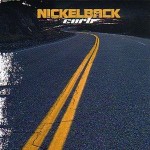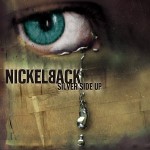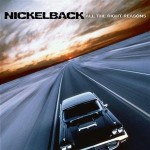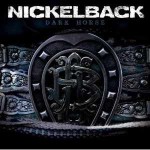I suspect someone is sitting there wondering “What? He’s doing a survey of a rock band? Him?!” Yeah, well, I know I haven’t done much of that here, but there are a couple of reasons for this essay. First, I like Nickelback’s music, which I tend to categorize as “loud, obnoxious, hard-ass rock ‘n’ roll.” (Which, by the way, is one of my favorite things. Truly.) Second, their discography offers a very clear look at a band’s development, from their fairly undistinguished and generic beginnings as part of a trend into ownership of a distinct identity and some very high-level music making.
 To be perfectly honest, if Curb had been my introduction to Nickelback, I wouldn’t be writing this commentary because I wouldn’t have listened to the rest of their music. It is pretty much interchangeable with any number of albums by any number of groups that fall under the “grunge” or “post-grunge” (or “post-punk” or “garage” or “post-garage” or whatever your take is on “alt/indie/post-something”) categories. What’s most apparent in this collection is a sense of strain: strain in the musical lines, strain in the vocals, strain in trying to fit what turned out to be a talented group of musicians into a box that doesn’t fit. It’s well done, but it’s pretty generic, from the standard-issue tunes to the faux-amateur vocals. (I call them “faux-amateur” because front man Chad Kroeger is a gifted singer who acquired a high degree of polish and — dare I say it? — artistry.)
To be perfectly honest, if Curb had been my introduction to Nickelback, I wouldn’t be writing this commentary because I wouldn’t have listened to the rest of their music. It is pretty much interchangeable with any number of albums by any number of groups that fall under the “grunge” or “post-grunge” (or “post-punk” or “garage” or “post-garage” or whatever your take is on “alt/indie/post-something”) categories. What’s most apparent in this collection is a sense of strain: strain in the musical lines, strain in the vocals, strain in trying to fit what turned out to be a talented group of musicians into a box that doesn’t fit. It’s well done, but it’s pretty generic, from the standard-issue tunes to the faux-amateur vocals. (I call them “faux-amateur” because front man Chad Kroeger is a gifted singer who acquired a high degree of polish and — dare I say it? — artistry.)
 The State, their second studio album, starts to show some glimmerings of an identity. Vocals still have that strained, angst-ridden quality — this is still very much “teenage music” — the overall style is still given mostly to noise, and the songs are somewhat general. They lack the details that can turn a lyric into a metaphor, but songs such as “Leader of Men” and even more, “Worthy to Say,” start to show something of what the band will become. It’s actually a very interesting album from the standpoint of Nickelback’s development: as one listens, one hears them more and more leaving behind the Nickelback of Curb and becoming the Nickelback of Silver Side Up and The Long Road. It also becomes apparent that they are not afraid to push things a little bit.
The State, their second studio album, starts to show some glimmerings of an identity. Vocals still have that strained, angst-ridden quality — this is still very much “teenage music” — the overall style is still given mostly to noise, and the songs are somewhat general. They lack the details that can turn a lyric into a metaphor, but songs such as “Leader of Men” and even more, “Worthy to Say,” start to show something of what the band will become. It’s actually a very interesting album from the standpoint of Nickelback’s development: as one listens, one hears them more and more leaving behind the Nickelback of Curb and becoming the Nickelback of Silver Side Up and The Long Road. It also becomes apparent that they are not afraid to push things a little bit.
 Something starts to happen with Silver Side Up. Suddenly, I’m hearing a strong country/blues element that I suspect was always there, but maybe hidden under the fuzz. It’s not only style — the fuzz blends with twang, the vocals are still guttural and somewhat artless, but they’ve become intelligible as well, and have lost that “risking herniated vocal chords” quality — but content: wife beating (“Never Again”), prison (“Where Do I Hide”), failed relationships (“Too Bad”), and one of those back-handed, somewhat elliptical love songs that Nickelback seems to come up with periodically (“How You Remind Me”). (I read it as a love song, although there is enough ambiguity in it that I’m not going to stake money on it. But then, that’s what makes it art.) And the songs start to become specific, they become small narratives, the little stories that are the backbone of country music. They move from generalized, adolescent songs about feelings to commentaries on real life and begin to take on that much more weight.
Something starts to happen with Silver Side Up. Suddenly, I’m hearing a strong country/blues element that I suspect was always there, but maybe hidden under the fuzz. It’s not only style — the fuzz blends with twang, the vocals are still guttural and somewhat artless, but they’ve become intelligible as well, and have lost that “risking herniated vocal chords” quality — but content: wife beating (“Never Again”), prison (“Where Do I Hide”), failed relationships (“Too Bad”), and one of those back-handed, somewhat elliptical love songs that Nickelback seems to come up with periodically (“How You Remind Me”). (I read it as a love song, although there is enough ambiguity in it that I’m not going to stake money on it. But then, that’s what makes it art.) And the songs start to become specific, they become small narratives, the little stories that are the backbone of country music. They move from generalized, adolescent songs about feelings to commentaries on real life and begin to take on that much more weight.
The country/blues influence also shows up in an element of — call it mournfulness that sometimes breaks into desperation, and also a willingness to get all out emotional — and after all, what else is music for? One reason I like this music is that it’s out and out Dionysian, moving between ecstasy and despair. “Good Times Gone” is a classic country rock song: melancholy, fluent, guitar twining in and out of Kroeger’s gravelly vocals that suddenly turn urgent, chorus and breaks filling in with a wall of texture, while the whole tenor of the song says that the blues are in the mix somewhere.
 The Long Road struck me on first hearing with something that I’m used to from classical music, not from pop: many of the songs echo each other, almost a theme and variations sort of thing, as melodies segue from song to song, not the same melodies necessarily, but melodies that resonate with each other, one step to the left of leitmotiv. This starts early on, with “Do This Anymore” and “Someday.” There’s enough of this going on that the entire album develops a remarkable flow, a sharp, coherent and sophisticated retelling of the so-called “concept album”, most examples of which seemed to have an outside concept imposed on them after the fact. This one’s organic.
The Long Road struck me on first hearing with something that I’m used to from classical music, not from pop: many of the songs echo each other, almost a theme and variations sort of thing, as melodies segue from song to song, not the same melodies necessarily, but melodies that resonate with each other, one step to the left of leitmotiv. This starts early on, with “Do This Anymore” and “Someday.” There’s enough of this going on that the entire album develops a remarkable flow, a sharp, coherent and sophisticated retelling of the so-called “concept album”, most examples of which seemed to have an outside concept imposed on them after the fact. This one’s organic.
 Being me, of course, my first real exposure to Nickelback was, as I noted, All the Right Reasons, at that time their most recent and most polished effort. (I tend to enter new realms wherever something catches my attention and poke around until I find someone with a map.) Hovering in the background of any mention of Nickelback are vague murmurings of “commercialism” and “lack of originality” (well, OK, not always that vague, and not always so far in the background), and I suspect that stems from the polish evident in this collection, the degree to which the music-making has become conscious and deliberate creation. I’m not going to deal with those cavils because I don’t care. They’re irrelevant. Kroeger said quite bluntly that the band was pushing boundaries in this album, trying some new things, but it becomes quite apparent that the framework was in place, and without a good, strong framework, you’ve got nothing to push against. What’s interesting here is the way in which All the Right Reasons puts what’s been there into focus.
Being me, of course, my first real exposure to Nickelback was, as I noted, All the Right Reasons, at that time their most recent and most polished effort. (I tend to enter new realms wherever something catches my attention and poke around until I find someone with a map.) Hovering in the background of any mention of Nickelback are vague murmurings of “commercialism” and “lack of originality” (well, OK, not always that vague, and not always so far in the background), and I suspect that stems from the polish evident in this collection, the degree to which the music-making has become conscious and deliberate creation. I’m not going to deal with those cavils because I don’t care. They’re irrelevant. Kroeger said quite bluntly that the band was pushing boundaries in this album, trying some new things, but it becomes quite apparent that the framework was in place, and without a good, strong framework, you’ve got nothing to push against. What’s interesting here is the way in which All the Right Reasons puts what’s been there into focus.
It’s become a music of textures, a kind of polyphony that finds parallels (and I use that word advisedly) in Beethoven and Brahms as much as Soundgarden or Nirvana. Nickelback passes phrases around with the best of them, different voices picking up the theme and never losing momentum: I distinctly remember listening to some of these songs — “Far Away” is as good an example as any — and thinking “Holy (expletive)! Beethoven does that!” (I don’t claim to have found any influences — it’s one of those things that composers do, after all, and they all do it, at one point or another.) Nickelback builds new soundscapes out of old materials — the hackneyed clichés that everyone uses and always has used, but they put them together in ways that say quite plainly “This is no one else.” I could go into detail here — the layered vocals, abrupt endings, repetitive phrases that take on a hypnotic intensity, staccato syllables that lead into held notes, resolutions left hanging — but I think you should just listen to the music. It’s all there.
It’s also music that goes for the gut. It’s not just Kroeger’s vocals, hard-edged and compelling as they can be. This is the value of experience and intelligence, and what I’ve seen develop over the course of these five collections: other bands try for the raw emotional punch that Nickelback delivers, and most of them just wind up either acting out or making a palatable gloss on the reality. There’s a powerful charge in a lot of Nickelback’s music that I have to confess I still don’t understand, but it’s there. They have the edge I’m always looking for
 Dark Horse came out a couple of days before I wrote this review. I was sure purists were going to hate this CD; as I suspected, it was immensely popular. It may be, if anything, stronger than their previous releases. Not sure yet: it changes all the rules It’s the distillation of everything they’ve done in the past, but more integrated, smoother, more polished. The anger is still there, the passion, but they’re making more intelligent use of it. I downloaded “Gotta Be Somebody” when it was available as the pre-release single, and I was worried: it’s this album’s version of “Far Away,” which I think of as their most “commercial” pop offering. It was not the Nickelback I wanted to hear all that much. In context, and taking the time to really listen, there’s much more to it than I had at first heard, which seems to hold true of the disc as a whole. It’s pretty deceptive. This one starts at high velocity and creates enough energy to keep it going even toward the end, when it slows down. (“Slowing down” being a relative term here.) Kroeger’s vocals are still pretty edgy, but he’s in better command of his resources. (I enjoy his singing a lot, but there are times I wish he’d pull back a little bit. I know he can do it, I just think he should do it more than he does, such as at the beginning of “Gotta Be Somebody” and even more, in the next cut, “I’d Come For You.”) They’ve built in a momentum here that carries through the entire album, even though the pace eventually gets down to human speed. There’s nothing that’s really new here, but it sounds new, and I think that’s a central element in Nickelback’s music-making: yeah, it’s been done, but it’s never been done quite this way. (There’s that identity thing again. And I wonder how far back I’d have to go in the history of music to find something really new. Homo afarensis? Did Lucy invent the blues?) And “this way” includes some very subtle, sophisticated music-making that can sneak right past you if you’re not on the ball — those little details that make all the difference.
Dark Horse came out a couple of days before I wrote this review. I was sure purists were going to hate this CD; as I suspected, it was immensely popular. It may be, if anything, stronger than their previous releases. Not sure yet: it changes all the rules It’s the distillation of everything they’ve done in the past, but more integrated, smoother, more polished. The anger is still there, the passion, but they’re making more intelligent use of it. I downloaded “Gotta Be Somebody” when it was available as the pre-release single, and I was worried: it’s this album’s version of “Far Away,” which I think of as their most “commercial” pop offering. It was not the Nickelback I wanted to hear all that much. In context, and taking the time to really listen, there’s much more to it than I had at first heard, which seems to hold true of the disc as a whole. It’s pretty deceptive. This one starts at high velocity and creates enough energy to keep it going even toward the end, when it slows down. (“Slowing down” being a relative term here.) Kroeger’s vocals are still pretty edgy, but he’s in better command of his resources. (I enjoy his singing a lot, but there are times I wish he’d pull back a little bit. I know he can do it, I just think he should do it more than he does, such as at the beginning of “Gotta Be Somebody” and even more, in the next cut, “I’d Come For You.”) They’ve built in a momentum here that carries through the entire album, even though the pace eventually gets down to human speed. There’s nothing that’s really new here, but it sounds new, and I think that’s a central element in Nickelback’s music-making: yeah, it’s been done, but it’s never been done quite this way. (There’s that identity thing again. And I wonder how far back I’d have to go in the history of music to find something really new. Homo afarensis? Did Lucy invent the blues?) And “this way” includes some very subtle, sophisticated music-making that can sneak right past you if you’re not on the ball — those little details that make all the difference.
A note about personnel: Nickelback has been a relatively stable band throughout its existence, and the current line-up (Chad Kroeger, vocals and guitar; Mike Kroeger, bass; Ryan Peake, guitars and vocals; and Daniel Adair, drums and vocals) have worked together for a while. It shows: it’s a solid, integrated sound, which is better than having a bunch of soloists up there fighting it out.
So, yeah, I’m very fond of Nickelback. Let me put it this way: what does a band have to have to push almost everything else off my playlist for an entire summer? That’s what Nickelback has.
Curb (Roadrunner Records, 2002 [orig. released 1996, Nickelback Productions])
The State (Roadrunner Records, 2002 [orig. released 1999, The All Blacks)
Silver Side Up (Roadrunner Records, 2001)
The Long Road (Roadrunner Records, 2003)
All the Right Reasons (Roadrunner Records, 2005)
Dark Horse (Roadrunner Records, 2008)
